Treasury avoids paying $4B to fraudsters this year in ‘whole of government’ strategy
The Treasury Department is giving state unemployment offices access to its Do Not Pay database, in a multi-pronged plan to stem fraud.
The Treasury Department is on track to keep billions of dollars from going to fraudsters this year, as agencies put new protections in place following a surge of pandemic-era spending.
David Lebryk, the fiscal assistant secretary of the Treasury Department, said on July 16 that Treasury will intercept about $4 billion of fraudulent payments by the end of the year.
Lebryk, in a keynote address at AGA’s Professional Development Training summit in Denver, Colorado, said agencies are taking a “whole-of-government” approach to addressing fraud, after scammers exploited emergency COVID1-19 pandemic programs.
“That really is a step increase, with respect to how we focused and doubled down, in terms of what are the root causes of fraud. How do we actually address them?” Lebryk said. “We are very optimistic that that $4 billion is going to turn into an even larger number, but it’s going to take really a whole community effort.”
Treasury intercepted about $650 million of fraudulent payments last year.
“This has to be a whole of government approach. It’s not the IG’s responsibility to stop fraud. It’s not the CFO’s responsibility to stop fraud. It’s all of our responsibility to stop fraud,” Lebryk said.
Lebryk said a working group within the Chief Financial Officers Council recently developed a catalog of more than 130 different fraud schemes agencies are encountering.
“We’ve reached across the agencies and said, ‘Where are we seeing fraud?’ And so, putting that catalog together now starts us to take a look at how can we look at the root causes.”
Treasury, he said, is also working with the Labor Department to give state unemployment offices access to its Do Not Pay database, which is meant to stem fraudulent and improper payments.
“Many of our programs are federally funded, state-administered programs, so that collaboration with the states has to be critical,” he said.
No ‘one-one-fits-all’ fraud prevention
The Government Accountability Office estimates agencies may have lost as much as $521 billion a year to fraud between fiscal 2018 and 2022.
The Office of Management and Budget, however, disagrees with that estimate.
Deidre Harrison, OMB’s deputy controller, said most agencies already have strong controls in place to prevent fraud, and that the federal government should avoid a “one-size-fits-all” to correct a problem that persists among a few agencies and programs.
“When we look at the data, we see that the vast majority of programs did a really excellent job. They have very low improper payment rates. They understand their customers and their recipients, and they are getting the money to them quickly and efficiently and effectively,” Harrison said.
“What we need to make sure that we are doing is getting the balance right, where we are identifying those programs and not requiring them to do a bunch of new compliance exercises, because we are trying to overcorrect and make sure that everyone has done it perfectly,” she added.
Harrison said OMB is taking an “agile oversight” approach to fraud prevention that brings watchdog offices into the discussion when agencies launch new programs.
“We are bringing our IGs and GAO and Congress in on the front end, before a payment ever goes out the door, to have a conversation about what are the risks for this program, what are the ideas that we have to mitigate those risks? How are we making sure that we have the processes set in place on the front end to do appropriate reporting on the back end?” Harrison said.
“That is the new way of doing business. That is not something that we should be doing when we have an emergency or when we need to get money out the door quickly. It is the way we should be doing program management for all programs,” she added.
Using AI to prevent fraud
Treasury is also relying on artificial intelligence and machine learning to flag suspected fraud.
“We at Treasury are very uniquely situated, because we sit at the top of the payment system. So while there may be a payment that’s being made from SBA, or a payment that may be being made from VA, those two agencies don’t necessarily always communicate with one another or have insights into the data in the way that Treasury does at that centralized level,” Lebryk said.
Lebryk said the department identified more than $350 million in check fraud last year, after running about 40 million checks it issued through a machine learning tool.
“We can really envision a world in which we’re scoring every government payment, much in the same way that your credit card company scores your payments, we should be doing real-time analysis on every single payment,” he said.
Treasury also recently implemented an account verification system that allows the department to verify whether an account is legitimate before issuing a payment. Last year, the Treasury made 40 million payments to new accounts.
“Quite frankly, if you’re looking at where is most of the fraud going to occur, it most likely is going to occur in that first payment. And so we really should be focusing a lot more attention on how do we identify whether that’s a good payment or not,” Lebryk said.
After gathering feedback from industry and government officials, Lebryk said, Treasury found that agency leaders sometimes see efforts to prevent fraud, waste and abuse as “in conflict with the delivery of the agency’s mission.”
“Agency leadership has a lot of priorities, and fraud, waste and abuse are often low on those on that list. It’s typically an unfunded mandate. Agencies don’t know how to get started. They don’t know they don’t possess the analytical skill set to actually do it in-house, data can be difficult to access. We see that quite frequently,” Lebryk said.
Other agencies are also doubling down on fraud prevention efforts. The Labor Department, for example, is embarking on a state-by-state refresh of unemployment insurance (UI) systems that were pushed to their limits at the height of the COVID-19 pandemic.
“A lot of really good things were done during the pandemic to help people in need and to make sure the economy went in the right direction, but at the same time, a lot of things happened that we know that money went to people that didn’t deserve the money, and a lot of fraud was committed,” Lebryk said. “We need to be in a position next time where those of us in this community can raise our hand and say we can get the money out the door quickly, but not reduce controls.”
Copyright © 2024 Federal News Network. All rights reserved. This website is not intended for users located within the European Economic Area.
Jory Heckman is a reporter at Federal News Network covering U.S. Postal Service, IRS, big data and technology issues.
Follow @jheckmanWFED






